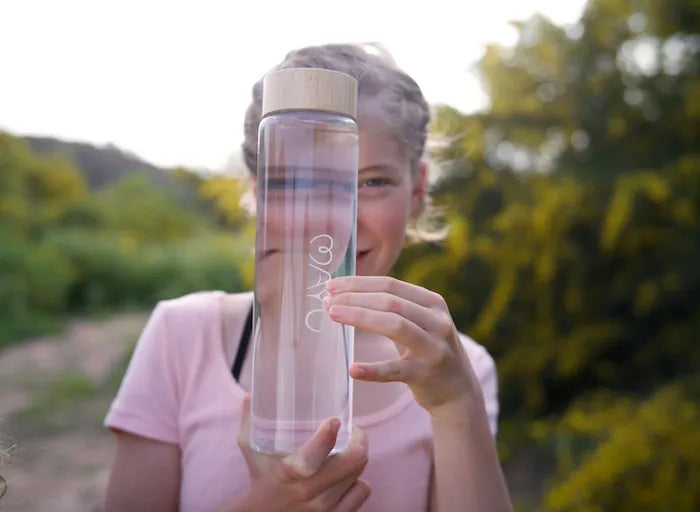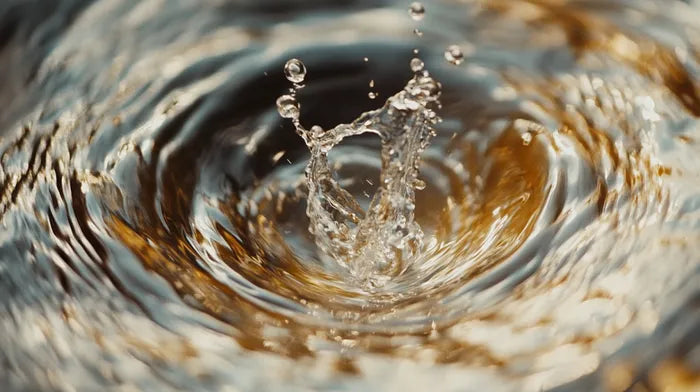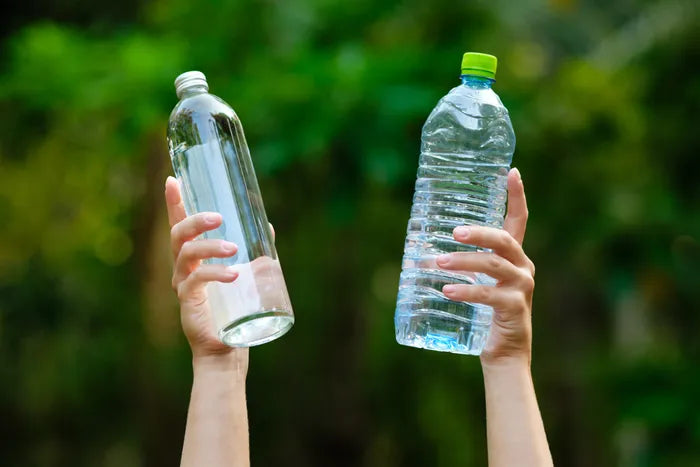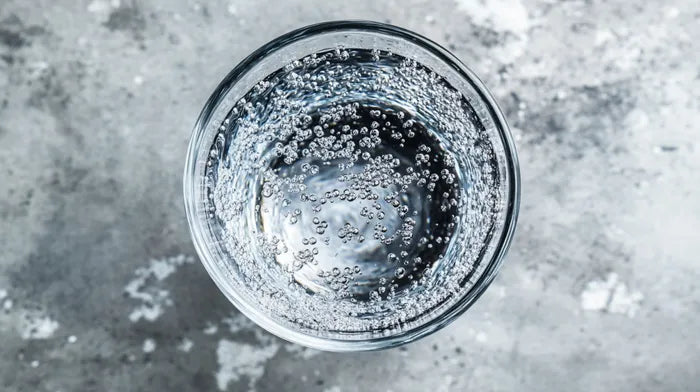PFOA vs. PFAS in Drinking Water: What You Need to Know
PFOA is one of many PFAS, persistent chemicals in our water that may cause cancer and disrupt your hormones. They're hard to detect, and even harder to remove. You can test your water, use a reverse osmosis filter, and avoid "non-stick" and "stain-resistant" products to avoid them.
Published June 2, 2025

Once PFOA and PFAS enter your water, they don’t leave. They accumulate silently in your body every time you take a sip.
A 2023 study found at least one of these chemicals in 45% of U.S. kitchen taps [1]. Not just at treatment plants [1]. Right at the faucet. Private wells and public systems were equally contaminated.
What's even worse is that the study only looked for 32 out of thousands of known PFAS. And in many samples, the levels weren’t just present, they exceeded what the EPA says is safe!
So what are these chemicals? What’s the difference between PFOA and PFAS? And how do you keep them out of your body?
Here’s what you need to know.
What Are PFAS and PFOA?
PFAS stands for per- and polyfluoroalkyl substances, which is a massive group of man-made chemicals. Thousands exist. You’ll find them in waterproof jackets, fast-food wrappers, and your drinking water.
PFOA is a type of PFAS. Specifically, it’s a long-chain perfluoroalkyl substance with 8 carbon atoms. That’s why you might also see it labeled as “C8.” All of those carbon atoms are bonded to fluorine, making PFOA nearly indestructible.
While all PFAS are concerning, PFOA is the most dangerous. It builds up in our bodies and has been linked to some of the most serious health risks, such as higher cholesterol levels and kidney and testicular cancer [2].
📌 Note: These chemicals don’t break down easily. They resist heat, oil, and water. And they’ve been used since the 1940s. That’s why scientists call them “forever chemicals.”
What PFOA and PFAS Do in the Body
PFAS don’t leave your system easily. They’re absorbed through water, food, and air. And they stick around.
Here’s what research has linked PFAS and PFOA to:
- Weakened Immune Function: PFAS interfere with your immune system’s response [3]. They can make vaccines less effective. They can make it harder to fight off infections.
- Increased Cancer Risk: Long-term exposure to PFOA has been associated with higher rates of kidney, liver, prostate, and testicular cancers [4].
- Hormone Disruption: PFAS affect thyroid function and reproductive hormones [5]. That means they can interfere with fertility, metabolism, and even child development.
- Fetal Harm: Babies exposed to PFAS in the womb are more likely to be born with low birth weight or show developmental delays [6].
Should You Worry About PFOA More Than PFAS?
Yes, and here’s why.
PFOA is part of a class called long-chain PFAS, which stay in the body longer and are harder to remove from water. Short-chain PFAS, by contrast, move more easily through the environment, but don’t build up in people as much.
Still, both types are dangerous. And most PFAS haven’t even been studied yet. What we know is alarming. What we don’t know may be worse.
How PFAS and PFOA Enter Your Water
Here’s how PFAS get into your glass [7]:
- Factories using PFAS release waste into nearby rivers or soil.
- Firefighting foams, used at airports and military bases, seep into the groundwater.
- Landfills leach PFAS from old packaging, furniture, and clothing.
- Wastewater treatment plants can’t filter them out completely.
Communities near airports, military sites, or industrial facilities are most at risk. And studies suggest that those communities are lower-income or majority Black or Hispanic [8].
Can You Test Your Water for These Forever Chemicals?
Yes. But it’s not always easy—or cheap.
- Lab testing (LC-MS/MS) is the most accurate. But it requires professional collection and costs hundreds of dollars.
- Mail-in kits like SimpleLab or Safe Home are easier. You collect a sample at home and mail it in. But most are for just a few common PFAS. And they often only detect levels above the safety limit, so you won't know if yours are running dangerously close.
How to Remove PFOA and PFAS from Your Water
Boiling your water doesn’t help. You need real filtration. Here are the best options:
- Granular Activated Carbon (GAC): Removes 80% or more of PFOA [9]. Common in many home pitchers like Brita and municipal systems.
- Ion Exchange Resins: Use electrically charged particles to attract and remove PFAS. Effective, but usually found in larger filtration systems [10].
- Reverse Osmosis (RO): The gold standard. Removes 90 %+ of PFOA and other PFAS. Higher up-front cost, but very effective [11].
Where Else Are You Exposed to PFOA and PFAS?
Your water isn’t the only problem. Here are five common sources of PFOA and other PFAS:
- Food Packaging: This generalizes "microwave popcorn bags and fast-food wrappers" to include a broader range of packaging for prepared foods, bakery items, and even some take-out containers. The goal is to make these resistant to grease and water.
- Non-stick Cookware: Non-stick coatings (like Teflon, a well-known brand of PTFE, which is a type of PFAS) are a very common source of PFOA exposure. Even if newer non-stick pans are "PFOA-free," they often still contain other PFAS.
- Water- and Stain-Repellent Products: Any items treated to resist water, grease, and stains. For example, you might find them in clothing, especially outdoor gear like rain jackets. Some stain removal products might also contain PFAS.
Why Haven't We Banned These "Forever Chemicals" Yet?
A full ban on PFAS might seem obvious. But it’s complicated.
These chemicals are still used in vital sectors like medicine, aerospace, and electronics [12]. A sudden ban could cause real disruption. That’s why most experts recommend a targeted phaseout: start with non-essential uses, regulate the rest tightly, and fund safer alternatives [13].
In short: Kill what we can. Control what we can’t, yet.
PFOA vs. PFAS: The Difference That Matters
PFOA and PFAS aren’t just technical terms, they’re a growing threat to the safety of your drinking water. PFAS is the family. PFOA is one of its most dangerous members. Both persist in the environment.
Both accumulate in your body. But PFOA’s structure makes it more likely to stick around and do harm. Understanding the distinction matters because your health depends on it. Testing, filtration, and awareness aren’t optional anymore. They’re tools to keep your water healthy.
References:
- “Per- and Polyfluoroalkyl Substances (PFAS) in U.S. Tapwater: Comparison of Public-Supply and Underserved Private-Well exposures and associated health implications,” USGS. Available: https://www.usgs.gov/software/and-polyfluoroalkyl-substances-pfas-us-tapwater-comparison-public-supply-and-underserved
- “How PFAS impacts your health,” Per- and Polyfluoroalkyl Substances (PFAS) and Your Health, Nov. 12, 2024. Available: https://www.atsdr.cdc.gov/pfas/about/health-effects.html
- A. P. Bline, J. C. DeWitt, C. F. Kwiatkowski, K. E. Pelch, A. Reade, and J. R. Varshavsky, “Public health risks of PFAS-Related immunotoxicity are real,” Current Environmental Health Reports, vol. 11, no. 2, pp. 118–127, Mar. 2024, doi: 10.1007/s40572-024-00441-y. Available: https://pmc.ncbi.nlm.nih.gov/articles/PMC11081924/
- V. M. Vieira, K. Hoffman, H.-M. Shin, J. M. Weinberg, T. F. Webster, and T. Fletcher, “Perfluorooctanoic acid exposure and cancer outcomes in a contaminated community: a geographic analysis,” Environmental Health Perspectives, vol. 121, no. 3, pp. 318–323, Jan. 2013, doi: 10.1289/ehp.1205829. Available: https://pmc.ncbi.nlm.nih.gov/articles/PMC3621179/
- F. Coperchini et al., “Thyroid Disrupting Effects of Old and New Generation PFAS,” Frontiers in Endocrinology, vol. 11, Jan. 2021, doi: 10.3389/fendo.2020.612320. Available: https://pmc.ncbi.nlm.nih.gov/articles/PMC7851056/
- Z. Liew, H. Goudarzi, and Y. Oulhote, “Developmental exposures to perfluoroalkyl Substances (PFASS): an update of associated health outcomes,” Current Environmental Health Reports, vol. 5, no. 1, pp. 1–19, Mar. 2018, doi: 10.1007/s40572-018-0173-4. Available: https://pubmed.ncbi.nlm.nih.gov/29556975/
- S. Y. Wee and A. Z. Aris, “Environmental impacts, exposure pathways, and health effects of PFOA and PFOS,” Ecotoxicology and Environmental Safety, vol. 267, p. 115663, Nov. 2023, doi: 10.1016/j.ecoenv.2023.115663. Available: https://pubmed.ncbi.nlm.nih.gov/37976959/
- J. M. Liddie, L. A. Schaider, and E. M. Sunderland, “Sociodemographic Factors Are Associated with the Abundance of PFAS Sources and Detection in U.S. Community Water Systems,” Environmental Science & Technology, vol. 57, no. 21, pp. 7902–7912, May 2023, doi: 10.1021/acs.est.2c07255. Available: https://pmc.ncbi.nlm.nih.gov/articles/PMC10233791/
- J. B. Burkhardt, N. Burns, D. Mobley, J. G. Pressman, M. L. Magnuson, and T. F. Speth, “Modeling PFAS removal using granular activated carbon for Full-Scale system design,” Journal of Environmental Engineering, vol. 148, no. 3, Dec. 2021, doi: 10.1061/(asce)ee.1943-7870.0001964. Available: https://doi.org/10.1061/(asce)ee.1943-7870.0001964
- “Cyclic removal and destruction of per- and polyfluoroalkyl substances from water using ion exchange, resin regeneration, and UV/sulfite reduction,” Journal of Water Research, Available: https://www.sciencedirect.com/science/article/abs/pii/S0043135424018153
- “Reducing PFAS in Drinking Water with Treatment Technologies | US EPA,” US EPA, Feb. 26, 2025. Available: https://www.epa.gov/sciencematters/reducing-pfas-drinking-water-treatment-technologies
- “PFAS Uses and Products.” Available: https://pfas-1.itrcweb.org/2-5-pfas-uses/
- “Risk Management for Per- and Polyfluoroalkyl Substances (PFAS) under TSCA | US EPA,” US EPA, Jan. 24, 2025. Available: https://www.epa.gov/assessing-and-managing-chemicals-under-tsca/risk-management-and-polyfluoroalkyl-substances-pfas
- A. Jolly, “The truth about ‘Forever chemicals’ in your sparkling water,” Soda Sense, Dec. 15, 2024. Available: https://sodasense.com/blogs/bubbly-blog/how-to-read-a-nutrition-label
Disclaimer: The information published by MAYU Water is not a substitute for the expert knowledge, advice, and recommendations of trained professionals. We strongly recommend consulting with industry experts and primary or scientific sources before making any health, research-related, or other important decisions.
FAQs
Does toothpaste contain PFAS
Some toothpastes may contain PFAS, but most do not. PFAS were historically used in certain dental products for their stain-fighting and spreading properties.
But, due to health concerns, many brands have phased them out. To be safe, check the ingredient list and look for fluoride-free or PFAS-free labels, especially in “whitening” or long-lasting formulas.
Do sodas have PFAS?
Yes, some sodas have been found to contain PFAS. These substances can enter beverages through contaminated water sources or leach from packaging materials. While the detected levels are generally low, they can still contribute to cumulative exposure over time [14].
According to a Consumer Reports study, several popular soda brands contained measurable PFAS levels.
- Coca-Cola: 4.25 parts per trillion (ppt)
- Diet Coke: 3.54 ppt
- Pepsi: 2.89 ppt
- Diet Pepsi: 1.73 ppt
- Dr Pepper: 2.90 ppt
- Sprite: 3.13 ppt
- Fanta: 2.45 ppt
- Mountain Dew: 2.67 ppt
Can boiling my water remove PFAS?
No, boiling water does not remove PFAS. It can make the problem worse. Boiling reduces water volume through evaporation, which may concentrate PFAS levels.
To effectively remove PFAS, use filtration methods like reverse osmosis, activated carbon, or ion exchange systems that are specifically certified for PFAS removal.
Can I get tested for PFOA?
Yes, you can get tested for PFOA (a type of PFAS) through a blood test, though it's not commonly offered in routine checkups. Some specialized labs and environmental health clinics provide PFAS blood testing, often at a cost.
These tests can show if you’ve been exposed, but they can’t predict health outcomes. If you're concerned about exposure, especially from water or work environments, talk to your doctor about testing and next steps.
What are the side effects of PFOA?
PFOA (perfluorooctanoic acid) is linked to several health risks, especially with long-term exposure. Studies have associated it with:
- Increased cancer risk (especially kidney and testicular cancer)
- Liver damage
- High cholesterol
- Hormonal disruption
- Reduced immune function
- Thyroid problems
- Developmental issues in children and during pregnancy












































